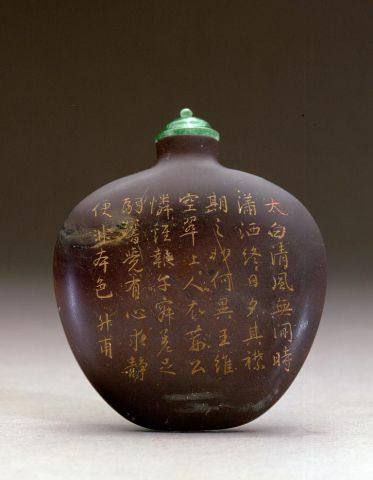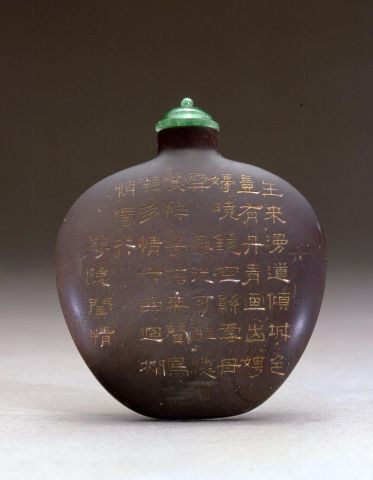

Bottle ID: 442
INSCRIBED, BOTH SIDES WITH POEM
Date: 1760-1880
Height: 59 mm
Duanstone, inkstone (slate), of purplish-brown color, of flattened shield shape with shoulders sloping to a flared neck and with a flat foot of elongated oval form, incised on one main side with an inscription in clerical script and on the other side with an inscription in draft script followed by the signature, Shengfu. The inscription in clerical script reads:
'Her natural beauty,
It goes without saying,
Could overturn a state,
So how could such loveliness
Be ever rendered in paint!
But her bright mirror hangs in vain,
Behind her mica screen.'
and
A spring day can really provoke emotion,
She sighs.
Though blossoms would speak but make no sound,
Bird songs are filled with feeling,
As along the railed path with its six bends
She quietly wanders,
Her lonely boudoir mood hidden among blossoming trees.'
The inscription in draft script reads:
'Li Bai's "A pure wind, without cease; Natural and free, blows day and night" - how does the marvelousness of the feeling it expresses differ from Wang Wei's "The blue sky gets on my gown"? As for Master Su, it is a pity that such an account of trivial matters as his "Afternoon Nap" is not up to carrying on the tradition, for all it does is give the impression that he just wants to find some peace and quiet, which is certainly not what real poetry should be about.'
Attributed to Duan.
Similar Examples:
Moss, Hugh, Victor Graham and Ka Bo Tsang. A Treasury of Chinese Snuff Bottles - The Mary and George Bloch Collection, 1998, Vol. 3, pp. 65-69, no. 395 and pp. 72-75, no. 397.
Provenance:
Hugh Moss [HK] Ltd.
Robert Hall, London 1999
Sotheby's, New York, March 22, 1999, lot 249
Duanstone is mined in the Duan region of Guangdong Province. It has been one of the most famous sites for mining stones for making into inkstones even prior to the Song dynasty. This lovely example is of the typical purple-brown range of stone from which the material earned the title ‘Purple Duan’. It is also one of the more beautifully inscribed examples known with highly literati inscriptions in two different scripts.
The inscription in clerical script refers to beauty toppling a city in ancient times when some of the kings and emperors were so infatuated by the beauty of their consorts that often, because they neglected their duties completely, they eventually lost their sovereignty to contenders. Ravishing beauties such as Liji (d. 651 BC) and Baosi, for example, have been blamed respectively for causing the downfall of the state of Jin and King You of the Zhou dynasty(r. 781-771 BC).
The inscription in draft script refers to Taibai, the sobriquet of Li Bai (701-762) the eminent Tang poet. Wang Wei (701-761 or 698-759) was Li Bai’s contemporary and famous a poet, painter and literatus. Master Su refers to Su Che (1039-1112), the younger brother of Su Shi (Dongpo - 1037-1101).
The couplet by Li Bai is from his "Nanxuan song (The Pine at Southern Veranda)."
The line by Wang Wei is from his "Shanzhong (In the Mountains)," but the original text has one character which is different, shi meaning 'wet', instead of shang meaning 'gets on'. This substitution was probably done because it was easier to inscribe shang, but the powerful effect of the original line, 'The blue sky wets my gown' is dramatically weakened.
Master Su's "Afternoon Nap" was typical of one major trend in Song Dynasty classical verse recording the trivial details of daily life, a past-time that later critics, who valued the intense expression and loft heights of Tang verse, utterly deplored.
It is exciting that Shengfu can be identified to some degree. Shengfu is the personal name of Bao Shi, who is only identified as living sometime during the Qing Dynasty. He was a native of Tongzhou, present day Nantong in Jiangsu. He is remembered as a noble and unsullied character who was an enthusiastic student of philosophical and historical works. He was an excellent poet, painter, calligrapher (in all script forms) and an especially fine seal script engraver, whose imposing tablet and stele inscriptions were thought to be unequalled in his time. Shengfu left two collections of writings, the Buyuanji (Literary Collection from the Recluse Garden) and the Maihua yin (Plum Blossom Songs). Biographical entries for Bao Shi appear in both 'Zhongguo huajia renming dacidian' and 'Guangyin renzhuan'.
Both of the similar examples from the Bloch Collection have calligraphy over the entire bottle. Number 395 is covered by a complete version of the Lanting Preface. Number 397 is of lobed form, within which are inscriptions relating to ancient bronze vessels.

 English
English 中文
中文